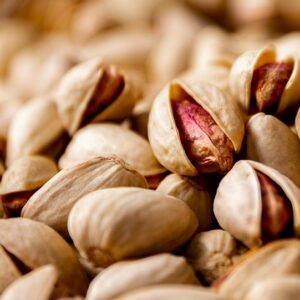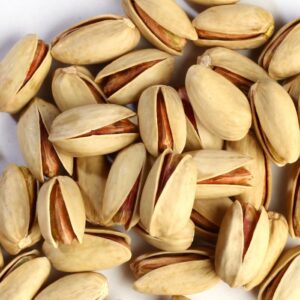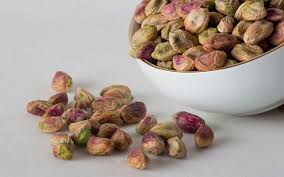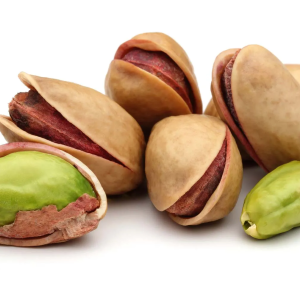
Origin of Pistachio
Pistachio, (Pistacia vera), small tree of the cashew family (Anacardiaceous) and its edible seeds, grown in dry lands in warm or temperate climates. The pistachio tree is believed to be indigenous to Iran. It is widely cultivated from Afghanistan to the Mediterranean region and in California.
The pistachio tree has wide-spreading branches but rarely exceeds 9 meters (30 feet) in height. Each leaf has one to five pairs of thick, wide, leathery, pinnate leaflets. The plants are usually dioecious (bearing either male or female flowers) and are pollinated largely by wind. Borne in clusters, the white drupe fruits are 1.5 to 2 cm (0.6 to 0.8 inch) long and tend to split at one side without discharging the seed. The “nut” is a greenish kernel enclosed in a thin, tightly adhering, reddish skin. The single, solid kernels have a pleasing mild resinous flavor. To ensure pollination and good yield, male trees are interplanted with female in a ratio of 1:5 or 1:6.
Pistachio history in Iran:
Emergence of pistachio in Iran back to HAKHAMANESHIAN period about 4000 to 5000 years ago. It seems that wild forest of pistachio has been cultivated about 3000 to 4000 years ago. Then, it has exported to the other parts of the world particularly Mediterranean nearby countries. The first origin of pistachio is located about Kerman province. After the Islam, Qom has been renowned as the most important region for pistachio cultivation. Its history respect to first half of the Hijri century and the first writings about Damghan pistachio, Semnan and Qazvin back to seventh century. On the other hand, Kerman Pistachio back to twelfth century.
Maintaining conditions:
Since the shell of pistachio does split when it has ripened to expose the nutmeat, this nut has a minimized shelf life (Filippone, 2017). When a farmer wants to store pistachio after harvesting in for a few days, it is recommended that the farmers should put the pistachio in resealable bags and keep them in the pantry (Filippone, 2017). Besides, when the farmer wants to store pistachio nuts for a longer period, it is recommended that the producer should store this nut in a container that is airtight and keep it in a freezer or refrigerator (Filippone, 2017). Moreover, unshelled nuts can be stored for more than three months in the freezer or refrigerator. To minimize condensation when thawing, the nuts are supposed to be placed in a plastic bag (Filippone, 2017). Nevertheless, pistachios that are shelled can be kept in the refrigerator for about three months, but should not be placed in a freezer. In addition, for one to restore pistachios that lack their crunch, they are supposed to be toasted in a 200F oven for about 8 to 18 minutes (Filippone, 2017).
Shelled
– Storing period must be maximum 12 months after the harvest
– Low humidity levels must be maintained at 50-60%
– Storage areas must be free from odors
– Storages must have license for operating
In-shell
– Storing period must be maximum 24 months after the harvest
– Low humidity levels must be maintained at 50-60%
– Storage areas must be free from odors
– Storages must have license for operating
The most important postharvest operations of pistachio nuts including handling, transportation, green hull removal, dehydration, bulk storage and packaging of pistachios were studied. Results showed that air temperature had pronounced effect on drying time and air velocity didn’t any significant effect on drying time. The entire drying process occurred in falling rate period and constant rate period was not observed. The optimum conditions for bulk storage of pistachio nuts were between 0 and 10 °C and relative humidity (RH) of 65-70 % or kept at higher than 10 °C (e.g. 15 °C) and less than 32 % RH, and monolayer moisture content had the longest shelf life due to the minimum changes in its lipid quality factors. The higher temperatures and longer storage times will accelerate deteriorative reactions in pistachio nuts especially on fat component and nylon under vacuum is the best packages for pistachio nuts among other packaging materials were studied in this research.
Pantry: 1-2 weeks Refrigerator: 3 months Freezer: 12 months
Competitive advantage:
Pros:
– Better taste and flavor in Iran pistachios
– Packaging diversity
– Ability to burst at high temperatures (without color and taste altering)
– The possibility of greater kernel percentage
Cons:
– Reduction of production in 2019 about one-quarter of the previous year due to climate condition and underutilizing cultivation year.
– Water scarcity, drought, water salinity and seasonal freezing in addition to production resources limitations and the lack of financial deficiencies.
– Weakness in warehouses systems, the lack of coherence in pistachio problem management
– Executing conventional method in production and trade.
– The scarcity of agreement purchasing
– Underestimating of production quality and health situation particularly in terms if afolatoxine
– The lack of strategic storage mechanism and product regulating among productive and nonproductive years.
– Low efficiency of production (production in area unit). Iran is lower than world efficiency by about 40%
Suggestions:
– Standardizing of pistachios to compete with highest quality (USA) in world.
– Stabilizing of world currency
– Planning for reducing the transportation cost and increasing the shipping lifespan
– Decreasing the finished price
Threats:
– Reducing the world market price of pistachio
Pistachio
Pistachio
Informations
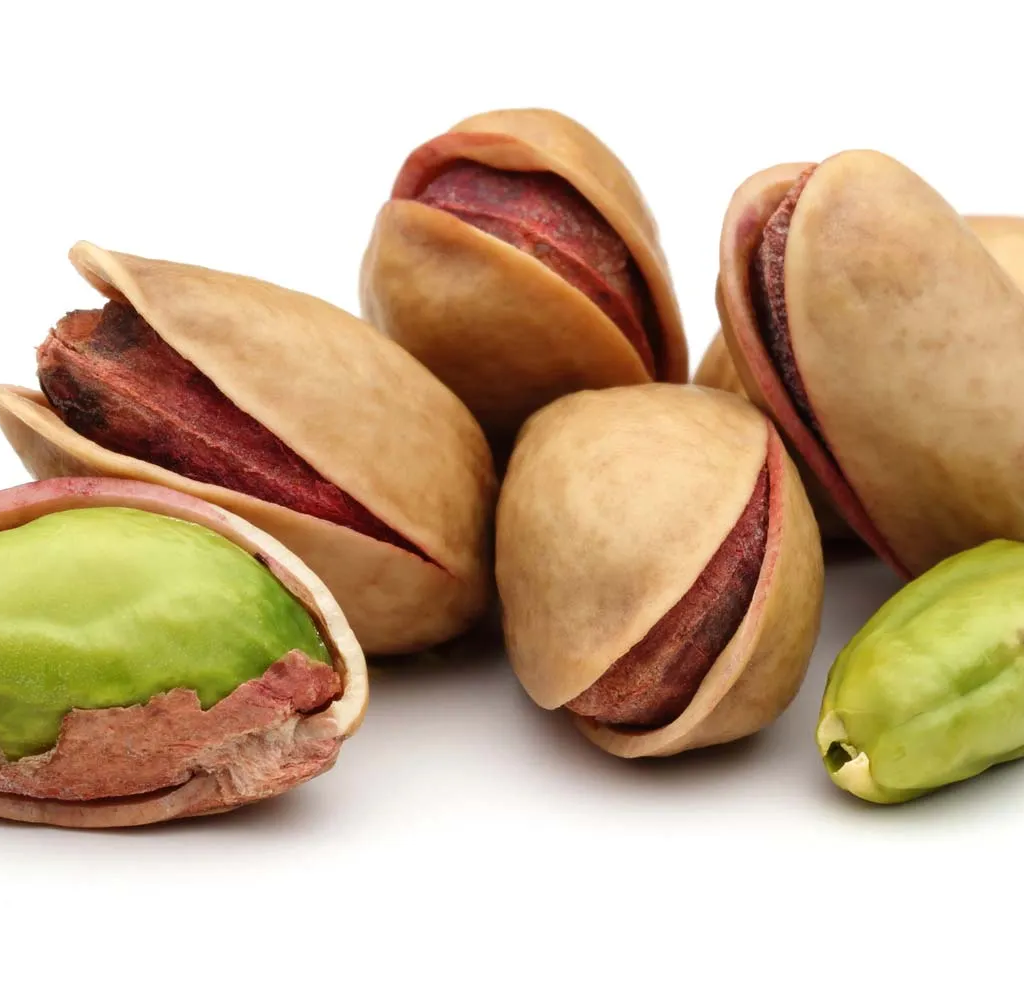
Pistachio is a green seed that has a very good taste and aroma. This seed has a lot of chlorophyll, that’s why its color is green. The shell of this seed is firm and helps to keep pistachios fresh. The nutrients in pistachios are so high that pistachios can be considered a complete food. Pistachios are very suitable for snacking and can provide vitamins to the body. Nutrients in pistachio are:
- Vitamin A,E,C • Sodium • Phosphorus • Zinc • Potassium • Iron • Magnesium
In general, pistachios are divided into two groups, round and long; which are known as Kale Ghochi, Fandgi, and Akbari… but traditionally in Iran about 90 types of pistachio are known; Some of them are widely and commercially cultivated and some are scattered and limited.
The most important commercial varieties of Iranian pistachios are Akbari pistachio, Khanjari pistachio, Kale Ghochi pistachio, Ahmad Aghaei pistachio, Fandghi pistachio, and Ohadi pistachio.
Characteristics of High-Quality Pistachios:
– Pistachio Freshness
– Having the right appearance
– Pistachio Smiling
– absence of Abnormal color
– Available in Coated and Uncoated Forms
– Available in Bulk and Retailed
Pistachio
One of Tidots’s specialties in the food industry is Pistachios. Let’s get to know
this product a bit more!
I. Identifications
Producers categorize pistachios in two different types as well which is more technical:
- Naturally Open Pistachios: pistachios grow on trees. if farmers leave the pistachios on the tree so that their kernels grow to crack open the hard shell, it will be naturally opened without any outside force. So, in other words, the shell opens on its own as the pistachio nut grows. This type is more expensive than the Mechanically opened pistachios.
- Mechanically Opened Pistachios: if the farmers harvest the pistachios before their kernels mature enough to crack open the shells, their shell is closed. As a result, the kernels of this type are smaller than the first category. Then, producers with the help of machines and some Technics, open the shells mechanically.

This type of Pistachio is the least expensive type among all the pistachios. The reason why its price is lower than other types is because of its shape and high production volume in addition to low domestic demand. So, Round Fandoghi Pistachio forms most of the volume of pistachio exported from Iran. The color of the Round Pistachio shell is naturally light cream. Also, it has the greenest kernel. Therefore, the greenness of its kernel and the reasonable price is the reason why producers mostly use Fandoghi to produce GPPK.
Farmers grow pistachios in provinces that have a proper climate for pistachios, such as Kerman, Khorasan, Yazd, Markazi o, r cities like Damghan.
The harvest season for necropsop is late September until Mid- October each year.
This type of Pistachio is the most delicious type among all the pistachios. The reason why it is tastier than the other type of pistachio is that it is fattier. The color of the Jumbo Pistachio shell is naturally light cream. As it is clear from its name, it has one of the largest kernels, and producers categorize it as extra-large pistachio. This type of pistachio (Iranian Jumbo Pistachio | Kale-Ghuchi Pistachio) is most similar to California pistachios. Also. it is one of the the high-demanded pistachios in Iran`s Market.
The name “Kale-ghuchi” in Farsi means the head of the animal Ovis Orientalis. Because this pistachio looks like the rams head.
A normal sort of Kaleghouchi pistachio:
- up to 7% moisture
- Max 2% close mouth pistachios
- Max 2.5% Semi-open pistachios
Farmers grow pistachios in provinces that have a proper climate for pistachios, such as Kerman, Khorasan, Yazd, Markazi, or cities like Damghan
This type of Pistachio (Long Ahmad Aghaei Pistachio) is one of the popular types. The reason why it is more popular than the other types of pistachio is that it has the lightest shell color. The color of the Pistachio shell is naturally light cream. However, Ahmadaghaie shell is brighter than the other types. As it is clear from its name, it is one of the long shape types of pistachios.
A normal sort of Ahmadaghaee pistachio:
- up to 7% moisture
- Max 2% close mouth pistachios
- Max 2.5% Semi-open pistachios
Farmers grow pistachios in provinces that have a proper climate for pistachios, such as Kerman, Khorasan, Yazd, , Markazi or cities like Damghan
Another name for Long Akbari Pistachio is Super Long Pistachio. This name is based on the shape of the pistachio. This type of Pistachio is the most expensive and the oldest pistachio type in Iran. The reason why this type is more expensive than others, is that this type is bigger than other pistachio types, even bigger than Jumbo Pistachio. The local demand for this pistachio is extremely high because of the form of this pistachio.
The color of the Pistachio shell is naturally light cream. However, the Akbari shell is darker than the other types and it is closer to cream. Also, it has natural brownish spots on the shell. As it is clear from its name, it is one of the long shape types of pistachios.
A normal sort of Pistachio Akbari | Super Long type :
- up to 7% moisture
- Max 2% close mouth pistachios
- Max 2.5% Semi-open pistachios
Farmers grow pistachios in provinces that have a proper climate for pistachios, such as Kerman, Khorasan, Yazd, Markazi o, r cities like Damghan.
Producers make Pistachio Kernel from all types of Pistachios. A quality factor for kernels is size. The more the color of the kernel`s second skin is violet and sharp the more it is popular among people. The higher the level of fat in pistachio kernels the tastier it is. Another interesting fact about pistachios shells is that as the kernel size grows the color the of kernel tends to be more yellow-ish. So, if the kernel is premature its color is more green.
Farmers grow pistachios in provinces that have a proper climate for pistachios, such as Kerman, Khorasan, Yazd, Markazi or cities like Damghan.
Grades Pistachio Kernels:
- Round Pistachio Kernel from Round Fanfoghi Pistachio, this type is more popular because of the competitive price.
- Jumbo Pistachio Kernel from Jumbo Kaleghouchi pistachio
- Long Pistachio Kernel, from Long Ahmadaghaee (Ahmad Aghaei) Pistachioor from Long Akbari Pistachio
III. Standards
Some predominant standards:
1. UNECE STANDARD DDP-09 & UNECE STANDARD DDP-10
2. IFS Food
3. FSSC 22000 Certification
4. BRC
5. HALAL WORLD
6. Fairtrade
7. Rainforest alliance
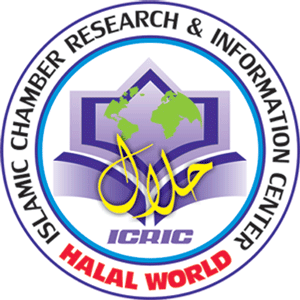
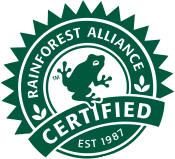

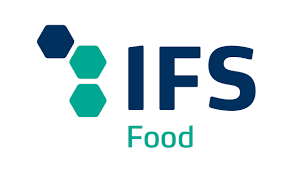
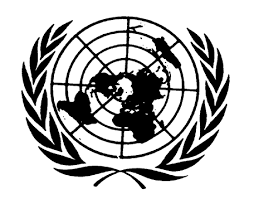

IV. Seasanoality
| Regions | Jan | Feb | Mch | Apr | May | Jun | Jul | Aug | Sep | Oct | Nov | Dec |
|---|---|---|---|---|---|---|---|---|---|---|---|---|
| Turkey | - | - | - | - | - | - | - | √√√ | √√√ | - | - | - |
| Syria | - | - | - | - | - | - | - | √√√ | √√√ | √√√ | - | - |
| South Africa | - | - | √√√ | √√√ | - | - | - | - | - | - | - | - |
| USA | - | - | - | - | - | - | - | √√√ | √√√ | √√√ | - | - |
| Khorasan(Iran) | - | - | - | - | - | - | - | - | √√√ | √√√ | - | - |
| Markazi & Semnan(Iran) | - | - | - | - | - | - | - | - | √√√ | √√√ | - | - |
| Kerman(Iran) | - | - | - | - | - | - | - | √√√ | √√√ | - | - | - |
| Yazd(Iran) | - | - | - | - | - | - | - | - | √√√ | √√√ | - | - |
V. Storage & Dimensions
Storage
The optimum conditions for bulk storage of pistachio nuts were between 0 and 10 °C and relative humidity (RH) of 65-70 % or kept at higher than 10 °C (e.g. 15 °C) and less than 32 % RH, and monolayer moisture content had the longest shelf life due to the minimum changes in its lipid quality factors. The higher temperatures and longer storage times will accelerate deteriorative reactions in pistachio nuts, especially on fat components, and nylon under vacuum is the best package.
Shell > Shelled
– Storing period must be maximum of 12 months after the harvest
– Low humidity levels must be maintained at 50-60%
– Storage areas must be free from odors
– Storages must have the license for operating
Shell > In-shell
– Storing period must be maximum of 24 months after the harvest
– Low humidity levels must be maintained at 50-60%
– Storage areas must be free from odors
– Storages must have a license for operating.
Dimensions
sizes of Round Pistachios
- 28-30 pieces/ounce (pcs/oz)
- 30-32 pieces/ounce (pcs/oz)
- 32-34 pieces/ounce (pcs/oz)
sizes of Jumbo Pistachios
- 20-22 pieces/ounce (pcs/oz)
- 22-24 pieces/ounce (pcs/oz)
- 24-26 pieces/ounce (pcs/oz)
sizes of Long(AhmadAghaei)Pistachios:
- 24-26 pieces/ounce (pcs/oz)
- 26-28 pieces/ounce (pcs/oz)
- 28-30 pieces/ounce (pcs/oz)
- 30-32 pieces/ounce (pcs/oz)
sizes of Long(Akbari) Pistachios:
- 20-22 pieces/ounce (pcs/oz)
- 22-24 pieces/ounce (pcs/oz)
- 24-26 pieces/ounce (pcs/oz)
VI. Packaging
VII. Processed Products
VIII. Health Benefits
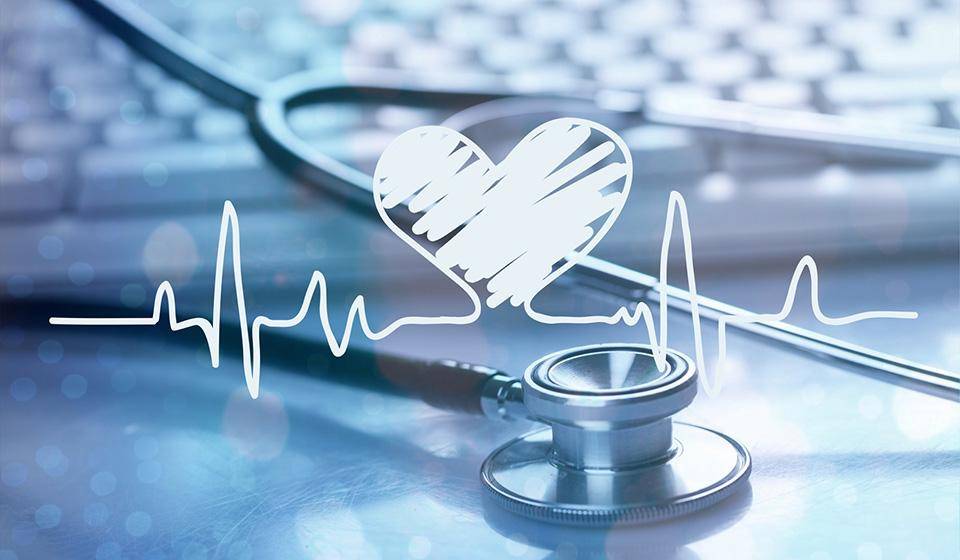
These are some important Pistachio benefits:
- Loaded with nutrients
- High in antioxidants
- Low in calories yet high in protein
- May aid weight loss
- Promote healthy gut bacteria
- May lower cholesterol and blood pressure
- May promote blood vessel health
- May help lower blood sugar
- Delicious and fun to eat
- Eyes Protection
Tidots
Mettmaner str. 119 - 40882 Ratingen, Germany
+49-162-4195257
Quick Links
Newsletter
Get in touch about our new services, products and events




